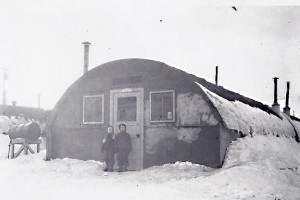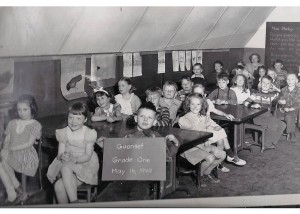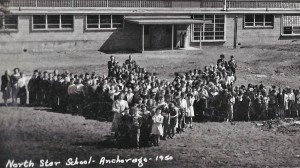Flying back home to Oregon from a family wedding in Anchorage, I cannot keep from reflecting on her changes over the years since I moved away. During this visit especially, I am aware of how “grown-up” Anchorage has become since we moved there in 1948, when the population was about 15,000. How different she is now compared to the “early days”!
I think of my grandchildren, who have grown up in a much different world than we did; theirs is a world full of cell phones and video games and wireless Internet. They are used to the hustle-bustle of modern Anchorage, riddled with freeways, coffee kiosks and retail outlets on every corner. They didn’t experience a Territorial Anchorage that ended at the Park Strip or a time when Anchorage International didn’t exist, or when there was only one High School in town. They didn’t know that you had to order from the Sears and Roebuck Catalog because the Northern Commercial Company didn’t have what you needed.
They didn’t go to 1st grade in a quonset hut, or live by lantern light when the neighborhood generator burned. They don’t remember when Northern Lights Blvd. was named KFQD Road after the radio station. They didn’t innocently play in the ash that dumped on Anchorage on July 10, 1953 from Mt. Spurr’s violent eruption. They didn’t see Anchorage rebuild after the devastating March 27, 1964 earthquake. They didn’t know that once Portage Glacier had huge amounts of ice!
On our (my brother Jack an my) first day of school in Anchorage in 1948, Mother was very apprehensive. The walk down Lois Drive to KFQD Road was cold, lonely, and very different from the Portland suburb we had just left. Here and there a few houses interrupted the landscape. At KFQD Road we caught the city bus, serving double duty as a school bus. I don’t remember that first day; nor do I remember why we didn’t ride into town with Dad, who drove to work. Luckily for Mom, we returned safely after school, none the worse for wear.
The only elementary school in Anchorage at the time was Chugach Elementary, and with an influx of new children in the area, overflow students were sent to Quonset huts nearby.

What is a Quonset hut you are wondering? According to Wikipedia, it is a “lightweight prefabricated structure of corrugated galvanized steel having a semi-circular cross section”. I remember it as being cold and dark. For example, imagine the inside of a pipe at 30º below zero. Not particularly warm or inviting, wouldn’t you say?
For the most part, all my classmates were in the same circumstances as we were. Many of their fathers worked for the federal government (Our Dad worked for the Bureau of Land Management). Home comfort was sparse and people made do with what they had. There were very little extras. We often commented that everyone in our early class pictures looked like they were dressed in hand-me-downs. We all arrived at school, however, with faces and hands washed and clothes not too terribly rumpled.
Mumps were rampant in the school that first winter and just before Christmas Jack managed to get them. Best to get it over with while he was young, Mother thought, hoping I would catch them too.
We spent the remainder of first grade and part of second in our Quonset hut. In February of 1950 North Star School on Fireweed Lane was completed, and we moved there. We did return to the Quonset hut for fourth grade, however, where during recesses, my friend, JoAnn, and I pretended we were Korean War spies. I still have fond memories of a small cardboard box full of secret papers that I brought to school each day.

Outdoor oil drums on wooden frames supplied fuel and fluorescent lights swung from the ceiling and provided light. Regardless of the dim interior and lack of esthetics, our Quonset hut appealed to the local mouse population, being warmer for them inside than out. More often than not when we arrived for the day, our books and papers would have tale-tell teeth marks from the little beasties having partied on our desks or in the bookshelves the night before. I imagine they spent the greater part of every night scurrying around looking for bits of lost sandwiches or cookie crumbs. Then, after tummies satisfied, they turned their attention to gathering whatever paper they could drag to their little nests, hidden beneath the weathered, wooden floor boards. This was all done, however, furtively, before a human came to clean. And this, being the frontier, didn’t happen on a daily basis.

As I was looking at the photo of our first grade class, I thought of how totally and completely ridiculous the dress code was! Girls just didn’t wear pants to school. You wore dresses and the outfit was completed with snow pants under your skirt, boots and heavy coats, hats and mittens. Inside the classroom, outer clothing was removed and hung on pegs on the wall; boots stacked neatly beneath. Even though it might be -30º or -40º outside, the corrugated walls of the Quonset hut were not overly insulated. The wind blew in through the cracks around the windows and snow often wandered in between the door and the threshold. Even though it was chilly inside and there was a distinct draft coming from just about everywhere, even with all these things, girls were required to wear their frilly little dresses to school to be in “appropriate attire”. Much to my chagrin, this requirement continued on until my late high school days. Probably explains why I prefer jeans to this day.
I can’t recall if I eventually came down with the mumps. Probably, or at least sometime I must have had them. I did eat far too much snow in the spring, however, and remember one grim day at the doctor’s office, huddled in an overstuffed chair while the doctor explained to my mother that I had pneumonia. I remember sobbing in utter terror. When I was three or four, I was confined to bed for an entire month with strep throat; there being no penicillin at that time. But fortunately, for me, penicillin, available by the spring of 1949, rescued me from pneumonia and I was out playing in the snow (and making snow ice cream) before long. In case you want it, the recipe for snow ice cream is:
SNOW ICE CREAM
A large bowl full of freshly fallen, clean snow, far from pathways, dog or moose tracks
Sugar
Condensed Milk
Vanilla
Mix and eat before it melts
Jana Ariane Nelson (nee Janet Griffith) moved to Anchorage in 1948 with her parents, Donald and Denney Griffith, and her twin brother, Jack.
Jana worked in the legal field in Anchorage before moving to Oregon. She retired from Lane Community College in Eugene where she was the Mathematics Division Coordinator.
Her daughter, Naomi Sweetman, is the Alaska DARE Coordinator and her son, John Nelson, is a financial advisor for Merrill Lynch in Anchorage. Jana has 4 grandchildren and one great grandchild in the Anchorage area. Her brother, Jack, runs the Griffith Lab at the University of North Carolina.
For more stories of early Anchorage, visit growingupanchorage.com.




